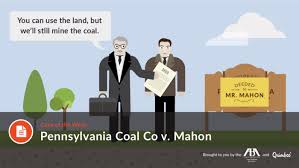Reflections on a Century of “Regulatory Takings” Law
A Century Ago, the Supreme Court Created a Transformative Legal Doctrine Out of Whole Cloth

One hundred years ago this month, the U.S. Supreme Court issued a radical constitutional decision that over the last century has proven enormously consequential in a host of environmental, natural resources and public health contexts. In the December 1922 decision Pennsylvania Coal Company v. Mahon, a divided Supreme Court created the constitutional doctrine of “regulatory takings.”
A bit of background is required to understand the significance of the Pennsylvania Coal decision, the constitutional principle it announced, and the profound legal and societal impact of the case a century later.
The “Takings Clause” of the Fifth Amendment to the U.S. Constitution–part of the Bill of Rights–provides in pertinent part: “[Nor] shall private property be taken for public use without just compensation.” Historians have established that the Takings Clause was the Founders’ response to the actions of British troops during the Revolutionary War seizing American colonists’ land and personal property to support the Crown’s war efforts.
For the first 130 years of the American nation’s history, the Takings Clause was widely understood to apply only to government’s physical seizure of private property. Such seizures could take the form of formal government proceedings to acquire private property for government use such as a city hall, highway, post office or public school–what lawyers refer to as “eminent domain” or “condemnation” actions. And the Takings Clause was also understood from the start to apply to government’s occupation of or damage to private property even where formal eminent domain actions had not first been commenced by the government. (Examples of the latter include razing a private building to limit fire damage to a community and the collapse of a government dam that floods and damages private property.)
And there things pretty much stood until Pennsylvania Coal. In that case, the coal company owned a parcel of land in the Commonwealth of Pennsylvania that contained substantial amounts of underground coal deposits. In 1878 the company sold the surface rights to the parcel to Mahon, who built a private home on the parcel, while the company retained the right to mine the underground coal. In 1921, however, the Pennsylvania Legislature passed a law–the Kohler Act–prohibiting the mining of underground coal in a manner that would cause subsidence of the property leading to damage or destruction of a surface dwelling. Relying on the statute, Mahon filed a lawsuit against the Pennsylvania Coal Company, claiming that the company was required to leave sufficient columns of coal in place to provide support for his surface structure and avoid dangerous land subsidence.
The Pennsylvania Supreme Court upheld the Kohler Act against the company’s claim that its application to the parcel in question would trigger a compensable taking of its mining rights, in violation of the Takings Clause of the Fifth Amendment. On review, however, the U.S. Supreme Court disagreed, ruling in favor of the company. In the process, the Court announced the then-novel principle that a law–even one enacted to protect public health and safety–could result in a “regulatory taking” of private property for which compensation is required to be paid by the government.
The majority opinion in Pennsylvania Coal was authored by Justice Oliver Wendell Holmes. Justice Holmes began by acknowledging that “[g]overnment hardly could go on if, to some extent, values incident to property could not be diminished without paying for every such change in the general law.” But, Holmes continued, the question is one of degree: “if regulation goes too far, it will be recognized as a taking.” Ultimately, he concluded that the Kohler Act crossed the constitutional line and violated the Takings Clause.
Another legal giant on the Court, Justice Louis Brandeis, wrote an impassioned dissent. Brandeis opined that the Kohler Act represented a reasonable exercise of government’s police power, and that the statute properly sought to avoid a potential health and safety hazard to people and surface dwellings alike. Allowing the coal company to proceed under these circumstances “would be a public nuisance,” Brandeis maintained. Accordingly, he concluded, no unconstitutional taking of the company’s mining rights had occurred.
In one sense, the Brandeis dissent in Pennsylvania Coal ultimately prevailed. 65 years later, the Supreme Court considered another “regulatory takings” coal mining case from Pennsylvania involving virtually the same factual circumstances. In its 1987 Keystone Bituminous Coal v. DeBenedictis decision, the Court ruled that another Pennsylvania statute requiring sufficient underground columns of coal to remain in the ground in order to protect surface structures from subsiding was a valid measure designed to protect public health and safety–and therefore not an unconstitutional taking of the coal industry’s property rights in the un-mined coal. Justice John Paul Stevens, writing for the Court, opined that “the Act is intended to serve genuine, substantial, and legitimate public interests in health, the environment, and the fiscal integrity of the area by minimizing damage to surface areas.”
Fair enough. But by that time, the “regulatory takings” genie had long since been let out of the bottle.
Justice Holmes’ decision in the Pennsylvania Coal case provided no real guidance to lower courts, private parties or government regulators as to when a challenged law “goes too far” and therefore constitutes a regulatory taking of private property. Sadly, a full century later, federal and state courts remain unable to fashion any bright-line standards to determine when a regulatory taking has occurred.
But that constitutional uncertainty hasn’t prevented members of the regulated community and private property rights advocates from asserting countless regulatory takings claims in their efforts to fend off a wide array of government statutes and regulatory programs. Land use regulation, pollution control laws, regulatory programs to protect wildlife (including endangered species), rent control laws, and the administration of state water rights systems have all been challenged on regulatory takings grounds. And in recent years the Takings Clause has been invoked in ever more exotic legal contexts: for example, to challenge government-imposed quarantines and temporary business closures during the height of the COVID epidemic; and banking and securities regulatory programs.
Many hundreds of regulatory takings cases have been filed and decided in the century since the Supreme Court decided the Pennsylvania Coal case. And hundreds of law review articles have been written analyzing regulatory takings doctrine and principles. In recent decades, regulatory takings claims have become the constitutional weapon of choice for regulated industries and businesses to challenge a wide array of environmental, natural resources, public health and other regulatory programs. Reasonable minds can differ as to whether the regulatory takings doctrine is a good or bad one. But close analysis of the Pennsylvania Coal decision reveals that it strayed dramatically from the plain language of the Takings Clause and runs counter to the intent of the drafters of the Bill of Rights.
Reader Comments
One Reply to “Reflections on a Century of “Regulatory Takings” Law”
Comments are closed.







Minor quibble: Neither the US Supreme Court decision nor the Pennsylvania supreme court decision concerned the Takings Clause. They both analyzed this as a potential violation of the Due Process Clause. The Takings Clause, in 1922, had not yet been applied to the states.